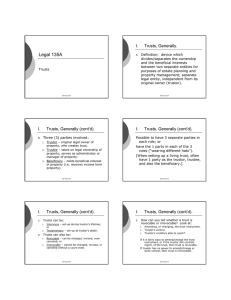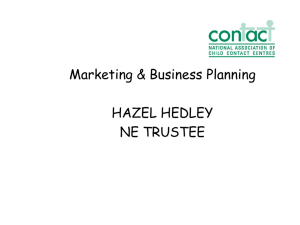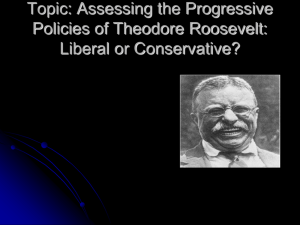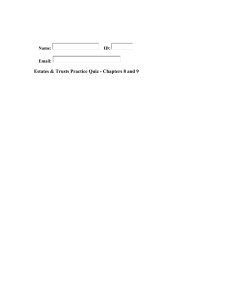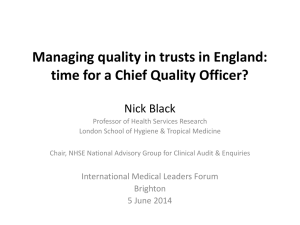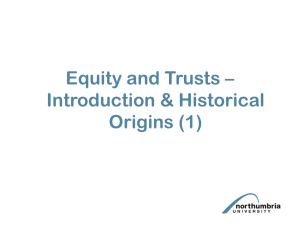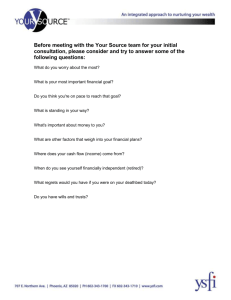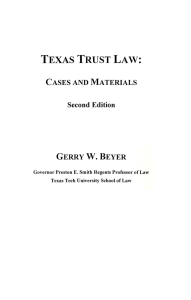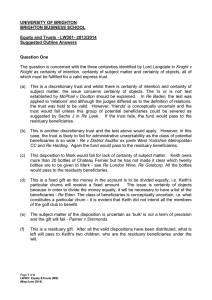The Living Trust
advertisement
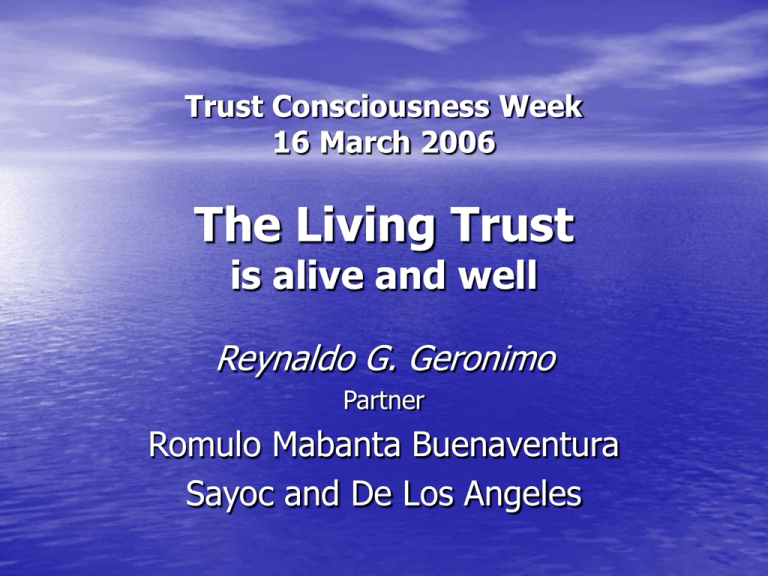
Trust Consciousness Week 16 March 2006 The Living Trust is alive and well Reynaldo G. Geronimo Partner Romulo Mabanta Buenaventura Sayoc and De Los Angeles Versatility of the trust device • trust “is an institute of great elasticity and generality; as elastic, as general as contract.” -Frederick William Maitland • “the purposes for which trusts can be created are as unlimited as the imagination of lawyers…The trust can be and has been applied as a device for accomplishing many different purposes” -Austin Wakeman Scott Elements of a trust relation • Trustor, or settlor, or grantor, or creator, or donor • Property, or trust res, or trust corpus, or principal • Transfer, or conveyance, in trust • Trustee, or fiduciary • Purpose, or objective • Beneficiary, or cestui que trust Who can be a trustor? • Generally: Anyone who has the legal authority to perform the act needed to effect a valid transfer in trust • Specifically: Testamentary trusts: 18 yrs + sound mind Inter vivos, gratuitous or for consideration: capacity to contract What property can be put in trust? • All things which are or may be the object of appropriation (Art. 414), whether real, or personal, or mixed • The property must be certain or definite • The property must be transferable What is meant by “transfer in trust”? • The settlor must “convey” his title over the trust • • res and must clearly show that he intended to create a trust. No particular words are required (Art. 1444). But if the trust res is real property, the document creating the trust must be in a public instrument, i.e. notarized, in order to be accepted as evidence (Art. 1443). To bind third parties, it must be registered (Sec. 50, Act No. 496) Who can be a trustee? • Any natural person, but aliens cannot be trustees of land in the Philippines • Any juridical person, if so authorized by their enabling charter: national or local governments, private corporations, partnerships • But, to engage in the business of trust, the trust entity must have a trust license from the BSP (Sec. 79, Gen. Banking Law) What purposes may a trust pursue? • Passive trust- objective is for trustee to be mere • • • • title holder Active trust- objective is for trustee to have affirmative duties of administration and management Private trust- for the benefit of identified persons Charitable trust- for the benefit of society as a whole Not for illegal purposes For whom a trust may be made? • Any person or group of persons who have juridical capacity • Excluded are persons who cannot receive by donation or will • Acceptance by beneficiary is necessary. But acceptance is presumed if no onerous condition is imposed Common kinds of trusts • As to mode of creation: – Testamentary trust – Intervivos or living trust • As to the finality of transfer – Revocable – Irrevocable – Reversionary • As to segregation of the trust res – Separately or individually managed trust – Participating trust in a “CTF”, now “UITF” More types of trusts • As to powers of the trustee – Full Discretion – Limited Discretion – Directory or directed • As to rights of the beneficiary – Spendthrift or protected trust – Fully transferrable interest • As to duration of the trust – Short term – Co-terminus with attainment of purpose Why the special focus on Living Trusts • BSP is about to issue a circular providing • • “Guidelines on Living Trust Accounts” This is in response to certain market behavior that is seen as systemic risk generating It is the latest move in the game of “hot potato” among three parties: (a) the regulator of banks; (b) the regulated banks; and (c) the clients of the banks. Structure of the proposed Circular • Lays down what it takes for a relationship to be • • considered a “living trust” under the Manual of Accounts for trusts Governs the method of marketing the service of being a trustee of a living trust Allows for a transitory period for trust entities to reconfigure their current trust accounts to conform to the new requirements and provides penalties for non-compliance General Criteria for trusts to be qualified as Living Trusts • Must be created by an Agreement and must be • • operational during the lifetime of the trustor as soon as the Agreement is executed. Beneficiary must be trustor and 3rd parties or 3rd parties only; not trustor only Agreement must specify (a) purpose, (b) nature and value of res, (c) trustee’s investment powers,(d) names of beneficiaries, and (e) terms of distribution of income and principal Specific Requirements-1 • Size: minimum entry is Php 100,000. • Investment area of initial fund: Php 100,000 to Php 500,000-ONLY in deposits • Lock-up: 6 mos. If terminated before that, account must be closed and trustor disqualified to open another one for one year. • Reversion of “principal and/or income”– allowed only upon revocation Specific Requirements-2 • Form: May be pre-printed, BUT, in that case,the Purpose Clause and Dispositive Clause must be left blank and filled out by client upon signing of Agreement. • Purpose clause- samples are provided. • Dispositive clause – Terms and conditions must be clearly defined – Must also be coordinated with Purpose Clause Specific Requirements-3 • Settlor/s – May be more than one in one Agreement – But, if so, must be related by consanguinity or affinity within the second degree • Marketing – Bank proper personnel cannot market Living Trust products or sign pre-printed Agreements – Bank Managers/Officers may refer clients to Trust Dept. and make short introduction of the products to clients Carrot and Stick • Carrot: Non-compliant living trust accounts have 3 months to comply • Stick – After 3 mos. – non-compliant living trust accounts will be TOFA, subject to reserves – Violations of Circular- subject to Sec. 37 of R.A. No. 7653, the New Central Bank Act Assessment by the TRUST GURU • The impending circular is a mere stop-gap measure • • to arrest the migration of funds from CTFs and UITFs pending completion of BSP’s over-all review of trust regulations. Last week, an international commercial law expert, Satish M. Kini, from the Washington law firm, GOODWIN l PROCTOR, was here to make an onsite study of our trust industry. I must disclose that we had two sessions, of more than two hours each, talking about my comments and observations on the trust industry. 1 Assessment by the TRUST GURU • The focus of the new issuance is not Living Trusts • • but Living Trust Accounts. The intention is to give guidelines in order to qualify an account as a Living Trust in the Manual of Accounts for trusts. The substantive nature of a Living Trust is not affected. What is sought to be achieved is the unmasking of deposits masquerading as trusts. • The honest-to-goodness Living Trust is still alive and well. 2 Thank You For related topics: www.thetrustguru.com

